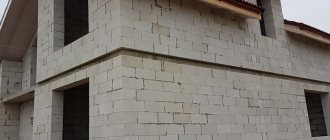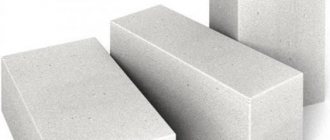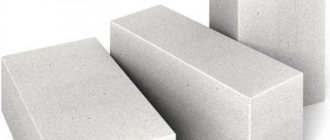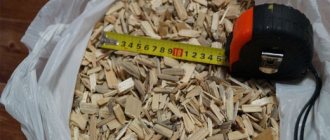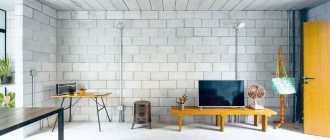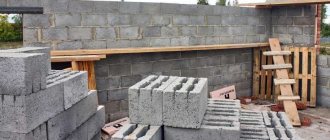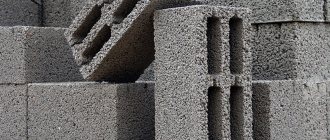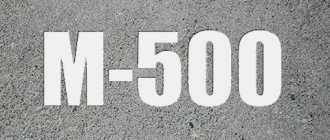Home |Blocks and floors |Technical characteristics of gas silicate blocks
Date: December 20, 2018
Comments: 0
In modern construction technologies, great importance is attached to the choice of material for the construction of one or another type of building. One of the most popular building materials today is gas silicate blocks, which have a number of advantages and are used quite often.
Their widespread use is due to the optimal balance of price and quality - by and large, no other building material maintains this proportion as profitably.
If you look at it, it’s unlikely that aerated concrete is a modern building material - it was developed back in the late 19th century. At the beginning of the last century, a group of scientists even patented the discovery of a new miracle material, but its properties were far from those that characterize today's gas silicate.
In its modern form, gas silicate material was obtained at the end of the 20th century - it is concrete with a cellular structure, the hardening of which occurs in an autoclave. This method was discovered back in the 30s, and since then it has not undergone any significant changes. The characteristics were improved by introducing refinements into the technology for its production.
Aerated concrete is one of the basis for the production of gas silicate blocks
What is silicate block
Silicate block is a lightweight and durable wall material that is made from pure natural materials (lime, sand and water). It has a high sound insulation rate, and also, due to its porous structure, has thermal insulation properties. The use of this raw material is extensive - the construction of residential buildings, garages, utility buildings, warehouses and office premises.
Advantages (pros)
- They belong to the group of non-combustible building materials and can withstand open flames for 3-5 hours.
- With such impressive fire resistance, autoclave-hardening blocks at the same time have high frost resistance.
- Since one block corresponds in size to several bricks, while being much lighter and more precise in geometric dimensions, the laying process proceeds at an accelerated pace.
- Well processed by cutting, drilling, milling.
- Eco-friendly, non-toxic - only natural materials are used in production.
- Thanks to high vapor permeability, walls made of gas silicate blocks are “breathable”.
Types of blocks
Let's look at what main categories the silicate block is divided into:
- Construction blocks. They are used in the construction of residential and public buildings, industrial facilities. The density of such material is at least 700 kg/m3;
- Structural and thermal insulation. This type is used when constructing load-bearing walls in low-rise buildings;
- Thermal insulation. They are used for insulation of building structures and thermal insulation of equipment in enterprises
Selection of gas silicate
When purchasing gas silicate blocks, three criteria are usually assessed that influence the decision:
- functional characteristics - density, frost resistance, thermal conductivity coefficient, etc.;
- dimensions of one block;
- volume of one block;
- price.
All this taken together allows us to draw conclusions about how capable this or that option is of coping with the tasks assigned to it, and to estimate the total cost of the material that will be used to construct the building.
Dimensions of silicate blocks
There is a wide range of building materials on the construction markets, but one of the important technical parameters that are taken into account when choosing is size.
The sizes of silicate blocks are distributed in values
from 500 to 600 mm in length;
from 200 to 250 mm in height;
from 200 to 600 mm in width
Dimensions and shape
A block is considered to be a product with a rectangular cross-section and a thickness slightly less than its width. In shape, a gas silicate block can resemble a regular parallelepiped with smooth surfaces or with grooves and protrusions at the ends (locking elements) - the so-called tongue-and-groove blocks; May have grab pockets. It is also possible to produce U-shaped blocks. Blocks are available in a variety of sizes, but the following limits should not be exceeded:
- Length - 625 mm;
- Width - 500 mm;
- Height - 500 mm.
According to the permissible deviations from the design dimensions, wall blocks belong to categories I or II, within which a certain difference in the lengths of the diagonals or the number of rib breaks are not considered rejection defects (for more details, see GOST 31360-2007).
Features of silicate block
When choosing a silicate product, you should take into account the subtleties of using this material. This knowledge directly determines how long a building or structure will last.
- frost resistance - the presence of a porous structure allows the building not to be afraid of sudden temperature changes, but the block cannot be used in a humid climate. Under such conditions, it becomes brittle and prone to crumble.
- amount of cement content. Please read this product information carefully. The more cement in the composition, the less moisture it absorbs (information is indicated on the packaging)
- shrinkage. The building material shrinks well. This fact must be taken into account
- radiation background. In order to avoid purchasing low-quality material, professionals advise measuring the level of background radiation. To do this, you need to use a household dosimeter
- dust. When working with this material, be prepared for a large accumulation of construction dust. Cleaning will be long and hard
Can I do it myself?
Conventional non-autoclaved gas silicate blocks can be made at home. It should be taken into account that without heat treatment such blocks cannot be used for load-bearing walls.
First the master will need to prepare:
- forms;
- Remedies;
- purchase components for preparing the solution:
- cement M 500, 2 kg;
- hot water, 1.4 l;
- sifted quartz sand, 2 kg;
- table salt 20 g;
- aluminum powder, 3 g;
- washing powder, 3 g;
- plasticizer, 20 ml.
Technology for the production of silicate for the home:
- Prepare the gas-forming mixture for 5 minutes. The reaction may be accompanied by the release of dust, so it will need to be carried out in protective clothing, a respirator, and goggles.
- Prepare a basic solution of sand and cement, mix with a mixing attachment on a drill until the composition is homogeneous.
- Add plasticizer, salt and no more than 1.2 liters of water to the resulting dry mixture.
- Stir the solution for 30 seconds and leave for the ingredients to soak in water; after a while, add the suspension and the remaining liquid, stir until a silver-colored film appears on the surface.
- Filling the forms is carried out only to 1/2 of the volume, the rest of the volume is formed independently.
- Leave the mixture in the mold until completely hardened.
Advantages and disadvantages of silicate blocks
The main advantages of silicate products are:
- strength - walls up to a nine-story level are built from this material
- simplicity of masonry work
- ideal geometry - flat surface with minimal deviations in size
- environmentally friendly material of natural origin. The raw materials include cement, sand, lime and water.
- soundproofing. This material has the highest index for this indicator on the building block market
- savings on finishing work. Due to its ideal shape, the need for additional plastering is reduced.
- speed of construction due to dimensions and tongue-and-groove connection system
For all its positive qualities, there are also a number of disadvantages:
- weighting of the material (weight per cubic meter is 1200 kg)
- additional insulation and cladding
- waterproofing, subject to the use of the material in rooms with high humidity levels
Manufacturing principle
The following substances are used as starting ingredients for the production of aerated concrete:
- sand;
- cement;
- lime;
- gypsum;
- water.
To obtain a cellular structure, a portion of aluminum powder is added to the composition, which serves to form bubbles. After mixing, the mass is kept for the required time, waiting for swelling, after which it is cut into pieces and placed in an autoclave. There the mass hardens in a steam environment - this technology is energy-saving and highly environmentally friendly. When producing aerated concrete, there is no release of harmful substances that can cause significant harm to the environment or human health.
Application of aerated concrete in construction
The main purpose of aerated concrete is the construction of houses, because aerated concrete blocks have characteristics that are very valuable for residential construction. Many are skeptical about it, considering the material fragile and unreliable. As proof, they cite examples of careless use of aerated concrete in construction, which is carried out without a design and by unprofessional teams.
Such accusations are not supported by anything concrete, but even a brick wall can crack if the foundation under it is incorrect or there are violations of the masonry technology. Meanwhile, from aerated concrete blocks you can build a house that is in no way inferior to a brick one, and in some ways it will even be better. In addition, there will be significant savings.
Another undoubted advantage is the ability to reduce construction time, since due to the light weight of the material, technological operations are carried out quickly. In addition, blocks (only autoclave, category 1) can be mounted not on cement mortars, but on polyurethane foam glue. The bottle replaces a 25-kilogram bag of the mixture; it does not need to be sealed with water, there is no need to carry heavy bags and pay for their delivery.
All the shortcomings attributed to aerated concrete are essentially far-fetched. This:
- Low density, due to which traditional fasteners do not hold well. There are specialized fasteners - the same dowels, only of a special shape. There are expansion anchors, and there are chemical ones. So there are no problems in hanging a kitchen set or water heater on the walls. But thanks to the low density, the walls are warmer, and this plus more than outweighs any minuses.
- Hygroscopicity is inherent to one degree or another in any concrete. To reduce this phenomenon, hydrophobic impregnations and finishing are used. With proper protection, which in principle all materials need, you can even build a bathhouse from aerated concrete.
- The restriction on the number of floors of a building is also untenable. You can build up to three floors - only when the load increases, you need to use denser blocks for laying the walls. Nobody builds private houses higher than three floors, as this is prohibited. In multi-story construction, aerated concrete blocks are actively used, but only as filling for a load-bearing reinforced concrete frame.
- The only real drawback of the blocks is their crack resistance. But again, if the house is well designed (especially in terms of the foundation) and built in full compliance with the technology, including mandatory reinforcement, there will be no problems with the occurrence of cracks.
But there are so many advantages: low background radiation, complete non-flammability, excellent ability to retain heat, a good level of sound insulation. And with all this, the material has a low cost, making aerated concrete houses the most attractive in price.
Briefly about the main thing
To understand what aerated blocks are, their advantages and disadvantages, you need to familiarize yourself with the production technology of the material and its technical characteristics.
The main components of the blocks are cement and purified sand. Due to the addition of aluminum, hydrogen is formed (gives porosity), calcined salt (gives stability and strength).
The main advantage of aerated concrete is its combination of light weight, high strength, density, thermal insulation properties, ability to breathe, and absorb noise. This is with high water absorption and relative fragility.
A wide range of sizes allows you to quickly build partitions and houses without renting lifting equipment.
It is easy to calculate the total weight of the structure being built if you multiply the volume of an individual element by its density, and the resulting result by the number of blocks used. There is no need to look at the indicators in the documents, since you always have a tape measure and a stamp with markings at hand. The numbers on it show the weight of a cubic meter of aerated concrete.
Approximate construction time
Strict geometric shapes and the use of modern adhesives allow you to very quickly build the box of a gas silicate house.
An experienced team of 5 people is capable of building a 10x10 m floor of a house in five working days . It will take a week to fill the armored belt and harden it. It takes one work shift to install the floor slabs. The roof is raised within 2 weeks.
If you build such a house yourself, then the construction of the box will take from 6 to 12 months, depending on the skill of the owner and the number of auxiliary workers.
What components does an aerated concrete block consist of?
The quality of aerated concrete depends on the quality of the components and equipment on which the blocks are produced. All ingredients are gradually mixed, foamed, and then they harden, creating a porous structure.
The components of aerated concrete are described below.
Cement
The quality of the binder component - cement - is regulated by the requirements of GOST 31108-2016. According to it, it is allowed to add the following types of cement to the mixture :
- TsEM I 32.5 or old marking PC400 D0 (without additives);
- TsEM I 42.5 or PC 500 D0;
- CEM II 32.5 or PC 400 D20 (20% of additives in the total mass of pure cement);
- CEM II 42.5 or PC 500 D20.
Sulfate-resistant cement cannot be added to aerated concrete blocks.
A lot depends on the brand and quality of the binder. For example, to create structural blocks you need to take M500 cement, for the production of structural and thermal insulation - M400 is suitable, and for the production of thermal insulation products - the cheapest cement M300 is allowed. Additives (marked with the letter “D” and numbers) improve the properties of aerated concrete .
Important: before using cement, you need to check its expiration date. A stale or expired binder component will spoil the quality of finished products. Each month of storage of cement takes away 10% of its declared strength.
Sand
According to GOST 8736-2014, you can use river, quarry or quartz sand of fine or very fine fraction.
The size of one fraction is from 0.1 to 0.5 mm. The smaller the grains of sand, the stronger the aerated concrete will be.
The presence of clay, silt or other impurities in the sand should not exceed 2% of the total mass. If the sand contains stones, dirt and other large components, then it must be carefully sifted several times.
Lime
Crushed quicklime is used - calcium hydroxide Ca(OH)2. The parameters for this ingredient are as follows (according to CH 277-80) :
- the quenching temperature must be at least 60°C;
- extinguishing time – from 4 to 15 minutes;
- presence of active CaO and MgO – from 70%;
- burnout – maximum 2%;
- the passage of fractions measuring 0.08 mm through the sieve must be at least 85%.
Water
According to GOST 23732-2011, you can use ordinary drinking water, which could be heated on equipment to 50-60°C in the summer and to 60-80°C in the winter.
Water in the mixture should not be more than 45-75% of the total mass of the mixture, and this figure depends on the brand of cement and its manufacturer, the temperature in the room and the temperature of the added components themselves.
Gas generator
Aluminum powder is used as a gas-forming component. It is this that, when reacting with water, causes the formation of hydrogen, which creates the porous structure of the blocks.
Some believe that aluminum powder is harmful to health , however, after the reaction is completed, the presence of free aluminum is so small that the environmental friendliness of the gas block can be compared with wood. And this has been proven by a lot of experiments.
The method of foaming aerated concrete using aluminum powder was discovered at the end of the 19th century and is still actively used today.
Advice : it is better not to use dusty aluminum, since during mixing of the solution it emits a lot of dust. Instead, it is recommended to use aluminum paste or powder.
GOST 5494-95 and STO 88935974-001-009 establish permitted grades of aluminum powder and paste. In the first case, this is PAP-1, as well as PAP-2. In the second option, these are 5-7370/75V, as well as 5-7370/75VS.
Other components from which the material is made
Sometimes the aerated concrete mixture contains gypsum, industrial waste (ash, slag), caustic soda (sodium hydroxide), sodium sulfate (sodium sulfate). The last component can be natural and technical, however, if technical sulfate is added, then it is needed 30-40% more than natural.
Economic benefit
Gas silicate blocks are easy to process: sawing, drilling, cutting, which makes it possible to use them in private low-rise construction with your own hands. Light weight allows you to do without lifting mechanisms. Reducing the cost of construction consists not only of saving on labor and equipment, but also in lower consumption of building materials and reducing the time to construct a building by four times. Due to the smooth surface of the material, masonry does not require adjusting the blocks to each other and leveling differences with a layer of binder. The blocks are held together with a thin layer of adhesive, which prevents the “cold bridge” effect that occurs when using a thick layer of cement in brickwork.
Conclusion
Gas silicate blocks are a cheap and effective material used in capital construction, repair and finishing. For the construction of individual structures, aerated concrete of maximum density and strength is used, and its lighter varieties are used to create cladding (insulation) and interior partitions. Construction should be carried out taking into account the low strength of the blocks and the tendency to shrinkage, compensated by a rigid reinforced foundation and the low height of the building.
Video description
You can learn more about foam concrete and aerated concrete in comparison from the video:
All the pros and cons of walls made of aerated concrete blocks come down to the porous structure and the properties of the main components: cement, sand. Compared to most analogues, the material is lightweight, which provides a small load on the foundation of the house and allows you to save on transportation or rental of lifting equipment during installation work. For laying smooth products, fine-grained glue with a layer thickness of only 3-5 mm is used. As a result, there are no cold bridges.
Glue distribution Source storage.spatiulconstruit.ro
Insulation outside and inside
Gas silicate blocks themselves are heat-resistant; in some cases they are used as an independent layer to protect a building from heat loss. Nevertheless, developers are often forced to insulate walls made of gas silicate.
When is it necessary?
The main reason why there is a need to insulate such a wall is its insufficient width.
This occurs either due to an error or intentionally, since the developer plans to initially construct a multi-layer load-bearing wall.
This choice can be made by technical and economic comparison of two options: single-layer and multi-layer.
Also, external thermal protection of walls is performed when reconstructing a building and transferring internal protection to an external load-bearing wall in order to free up additional volume in the room or change the finish.
Materials for thermal insulation
When choosing an insulator for insulating such a wall, you need to take into account its features:
- low moisture resistance;
- good vapor permeability.
The selected insulator should increase the first characteristic and leave the second unchanged. In this regard, it is not recommended to install polystyrene foam, which is vapor-tight.
Basic materials for use in thermal protection systems for gas silicate wall structures:
- Mineral wool has good heat and sound protection characteristics, but is also hygroscopic, so when using it, a layer of waterproofing is required. High fire resistance, environmental safety, availability and low price make this insulator the most popular of all types of thermal protection. The disadvantages include the difficulty of installing and securing slabs with a thickness of 100 to 200 mm.
- Polyurethane foam is a gas-filled polymer. It has high thermal characteristics and creates a durable protective layer. Easy installation and high maintainability of the material. But it has many disadvantages, the main ones of which are high price, the need for special equipment for spraying, increased fire hazard and poor protection against acid solutions.
- Penoplex is a modern heat insulator that eliminates the disadvantages of foam plastic; it is vapor-permeable and moisture-resistant, and does not support or propagate combustion. True, when smoldering, it releases toxic substances. The material is easy to install and lasts for more than 50 years. The only disadvantage is the high price.
Thermal protection installation technology
When externally insulating such wall structures, the best choice is mineral wool or Penoplex, and the best installation scheme is ventilated lathing. For internal thermal protection, it is better to use Penoplex.
Stages of creating thermal protection for a house from gas silicate on your own :
- A vertical sheathing under the mineral wool is installed along the border of the basement structure.
- Treat the sheathing with an antiseptic.
- Install a layer of water vapor barrier from below with an overlap of at least 15 cm and protect the joints with tape.
- The slabs are first secured with glue, and after drying - with special dowels.
- The next row is performed with offset seams.
- After the material has settled, the 2nd layer of water vapor barrier is laid.
- Install a counter-lattice with a ventilation gap.
- The cladding can be done with siding or decorative brick.
- It will be necessary to additionally install a fiberglass reinforcing mesh under the plaster.
Size chart
Today, most manufacturers produce bricks of different sizes on the building materials market, including white brick - silicate block. Its dimensions are as follows:
- Single – dimensions 250 x 65 x 120 mm (L x H x W), average weight – 3.6 kg. This proportion of brick sides is the best for alternating transverse and longitudinal placement of blocks in masonry.
- One and a half (modular) - has dimensions 250 x 120 x 88 mm, weight - no more than 4.3 kg. Basically, such brick blocks are hollow with a corrugated surface.
- Double – dimensions 250 x 120 x 103 mm. Basically, this type of block is hollow, so it is most often used for lightweight masonry.
Purpose of the material
According to their purpose, white bricks are distinguished as follows:
- Construction blocks, called ordinary blocks, are solid silicate blocks with a small number of voids. The characteristics provide this material with high strength, which makes it possible to install load-bearing walls, columns and pillars, and partitions between rooms. The presence of roughness, cracks or chips on this material is allowed, since the masonry will subsequently be covered with finishing.
- Facing bricks are hollow bricks that are used for facade cladding. The main requirement for them is uniform color and even shapes without damage. They can be covered with decorative imitation.
Proportions
The illustration shows the process of creating aerated concrete blocks using the autoclave method . This means that the elements enter a special oven, where they are treated with high pressure (12 bar) and high temperature (180-190°C) for 12 hours, which gives the mixture strength and low shrinkage.
Interesting fact : when the mixture is poured into molds, the filling occurs only up to half of the mold, since within a few hours the solution will rise in volume. Final hardening occurs only on the 28th day.
If the blocks harden without an autoclave, then hardening occurs naturally, but the performance indicators drop several times. But this method is available for home use and allows you to save about 30% of your budget.
For 1 m3 of aerated concrete with a density of D500, produced by the autoclave method, you need:
- Cement – 286 kg.
- Sand – 234 kg.
- Water – 208 l.
- Aluminum powder – 544 g.
- Sodium sulfate – 4.6 kg.
- Caustic soda – 3 kg.
For 1 m3 of aerated concrete produced by the non-autoclave method, it is required:
- cement – from 51 to 71% of the total mass;
- sand – from 0.6 to 3.5%;
- aluminum powder – from 0.01 to 0.15%;
- lime – from 0.04 to 0.7%;
- gypsum – from 0.1 to 0.4%;
- calcium chloride – from 0.5 to 3%;
- water - the remaining interest.
Specifics of working with gas silicate bricks
Beautiful photos of houses made of autoclaved aerated concrete often appear on social networks due to the huge demand for the material. But experts advise that before starting low-rise construction, you should familiarize yourself with the nuances of using silicate products.
Construction planning
Aerated concrete blocks are better for building a house, but work must begin with design:
- When choosing a site, pay attention to the type of soil. In swampy areas and soils with high groundwater levels, fungus can develop in porous structures;
- decide on the number of floors and area of rooms - a large house made of gas silicate blocks involves significant costs;
- design communications. It is more difficult to install them in a finished building;
- calculate how many gas blocks are needed for work. Obtain the volume of the silicate wall (without window and door openings) by multiplying by the thickness and length. Divide the result by the volume of one product and get the quantity.
Example. For a building with dimensions of 10x10 and walls 3 m high and 30 cm thick, you will need 44 cubes of gas bricks. With an average cost of 3.5 thousand rubles. per cube you will spend 154 thousand rubles.
Choosing a foundation
For the stability and strength of load-bearing structures, you will need a monolithic foundation. Taking into account the pouring of the reinforced concrete reinforcing belt, it is necessary to evenly distribute the mass of the roof and rafters. Builders recommend building the foundation for a house from several types of gas silicate blocks.
